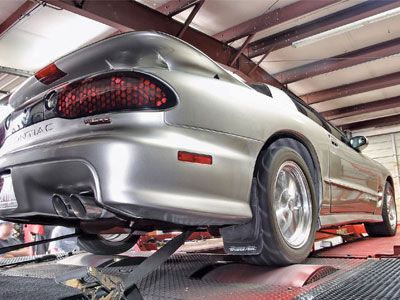
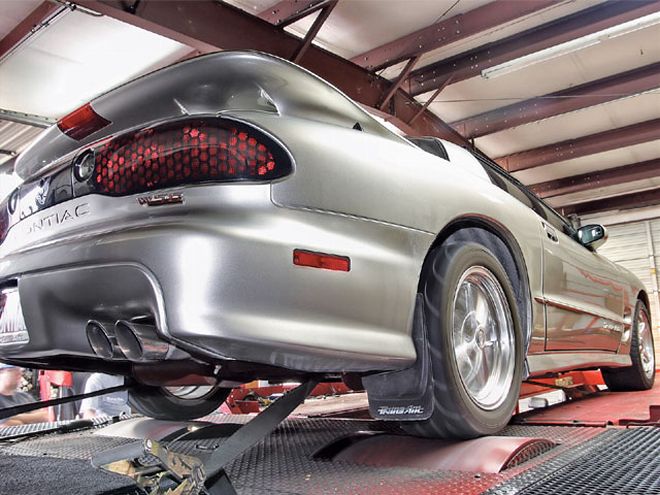
Part I: Intake And Exhaust Installation And Dyno Test
While just about everyone would love to have a new 505-horsepower LS7 powering their Bird, budgetary restraints and the desire to retain the original powerplant leave many owners considering other methods to increase engine output. For those who have already done many of the free mods (HPP, "Bolt-On Inspiration," July '06) but still want to bump up the power and retain driveability. Over the next two issues, we'll show you a combination of parts that will increase flywheel horsepower close to 75.
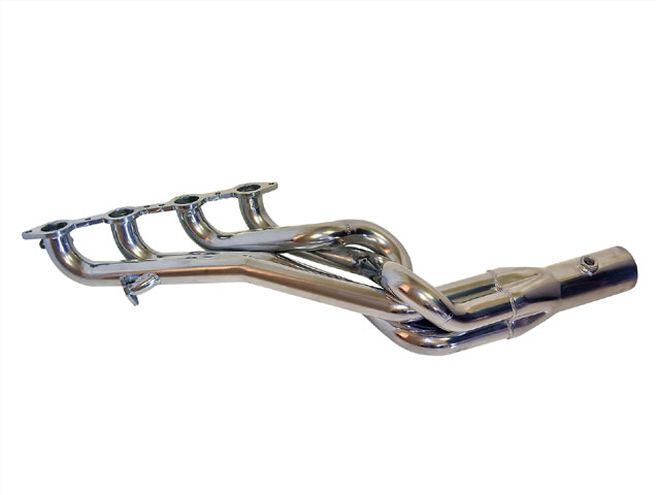 Jet-Hot headers are available for all '98-'02 LS-equipped Firebirds. PN 2533 (retail $500.95) is specifically designed for '00 applications that have both AIR and EGR provisions. The full-length headers are designed by Jet-Hot and feature 1.75-inch primaries and a 3-inch collector.
Jet-Hot headers are available for all '98-'02 LS-equipped Firebirds. PN 2533 (retail $500.95) is specifically designed for '00 applications that have both AIR and EGR provisions. The full-length headers are designed by Jet-Hot and feature 1.75-inch primaries and a 3-inch collector.
To set a foundation for big-power gains, LS-series engines can reap the benefits of exhaust and intake upgrades to make the most of the factory camshaft. If more power is desired, the next phase is a cam swap and valvetrain upgrade, which will come in Part II of this story. Known as "cam-only" cars, these LS-powered Pontiacs are potent performers. While gains greater than those that will be noted are certainly possible, our goal is to increase horsepower and torque across the board and create a power package that could just as easily run across town for a local cruise as it could lay down some serious power at the track.
According to Keith Lohse, of Real Performance Motorsports (RPM), in Lewisville, Texas, "Once an owner has completed the free mods and done some of the popular cost-effective upgrades, such as an aftermarket airlid or after-cat exhaust, many step up to a cam-only combination that nets them between 370-410 rear-wheel horsepower, based on the components selected."
In order to make that type of power, first a quality set of long-tube headers and free-flowing exhaust must be installed. Then, for pre-'01 Birds, the LS1 manifold is swapped out to an LS6 manifold as it has consistently shown the ability to generate at least 10 rwhp on an LS1 and can support upwards of 500 rwhp on nasty stroker builds. In order to get the exhaust and intake to support the cam-only build, we turned to Jet-Hot Coatings and SLP Performance Parts.
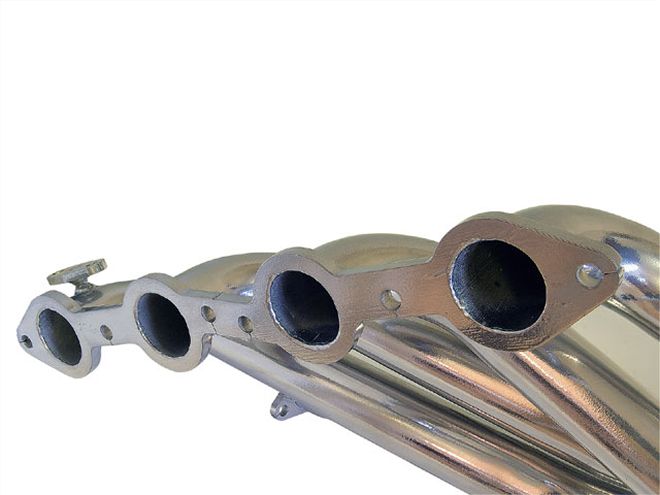 Constructed of heavy 16-gauge steel and featuring thick 3/8-inch flanges, the headers have high-cost features for a budget price. In addition to ensuring that the primary tubes don't protrude into the flange to rob power, both sides of the flange are welded, as are the AIR and EGR provisions. The Sterling finish is attractive as well as functional.
Constructed of heavy 16-gauge steel and featuring thick 3/8-inch flanges, the headers have high-cost features for a budget price. In addition to ensuring that the primary tubes don't protrude into the flange to rob power, both sides of the flange are welded, as are the AIR and EGR provisions. The Sterling finish is attractive as well as functional.
Matt Pertrauskas of Jet-Hot Coatings states, "Although there is a large variety of header and Y-pipe combinations available on the market for the LS1 F-body, our comprehensive catalog of headers and Y-pipes allows an owner to choose a system that will support his power goals. For this application, our long-tube headers with high-flow catalytic converters and Y-pipe will maximize the power potential of the LS1 and are unique in that they allow an owner to remain 49-state emissions legal or to swap out the converters for test pipes to run in an "off-road" configuration. Our headers and Y-pipes are coated inside and out with our proprietary Jet-Hot Sterling Silver coating, which will decrease underhood temperatures approximately 300-400 degrees and look great for years to come. In fact, the system carries a lifetime corrosion warranty and a three-year finish warranty."
Follow along as we install a set of Jet-Hot headers and a Y-pipe on an '00 WS6 Trans Am, then swap out the LS1 manifold for an SLP Performance Parts' LS6 intake manifold that retains the stock EGR system capability. The subject car is owned by Harold Baker, an information systems security engineer from Richardson, Texas. Now retired from daily driver duties, the automatic-equipped Bird carries 64,000 miles and is cruised for fun and used to bracket race in the Texas Muscle Car Club Challenge series. Equipped with a Corsa after-cat exhaust, BBK 80mm throttle body, a bevy of free mods and aftermarket suspension, this potent T/A is primed for an LS1 Power Plan.
Installation and testing of the modifications were done at RPM, which specializes in late-model General Motors performance and can take care of all of your Firebird, GTO and Grand Prix needs.
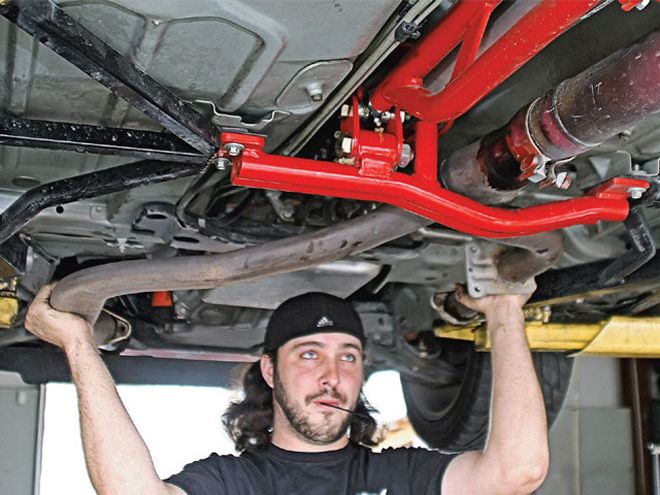 Y-pipe-to-transmission crossmember-bolts are taken out and the Y-pipe is separated from the after-cat junction by gently tapping it toward the front of the vehicle and twisting until it comes free. The Y-pipe is lowered and a 7/8-inch wrench removes the four O2 sensors from the catalytic converters and exhaust manifolds.
Y-pipe-to-transmission crossmember-bolts are taken out and the Y-pipe is separated from the after-cat junction by gently tapping it toward the front of the vehicle and twisting until it comes free. The Y-pipe is lowered and a 7/8-inch wrench removes the four O2 sensors from the catalytic converters and exhaust manifolds.
Conclusion
After the installation and dyno testing concluded, the '00 T/A gained 25.8 rear-wheel horsepower and 21.6 lb-ft of torque at the peaks. Although peak horsepower and torque are important, the best gauge of the effectiveness of the changes is reflected in the average power gains. Mathematically, the numbers show average gains of 19 and 20 rwhp and torque gains respectively, but by themselves the numbers don't tell the whole tale.
Baker states, "Power has been significantly increased from off-idle to the redline. Although I was worried that large primary, long-tube headers might decrease power in the lower rpm range, those worries were quickly put to rest on the testdrive home. Having a system that has the ability to support both the EGR and AIR valves on the header itself was important. There are a few manufacturers that offer long-tube headers featuring the Y-pipe and test pipe/catalytic converter design that allow the car to be emissions-legal with a few turns of a socket wrench. Overall, the quality of the system and the header/Y-pipe clearance are excellent."
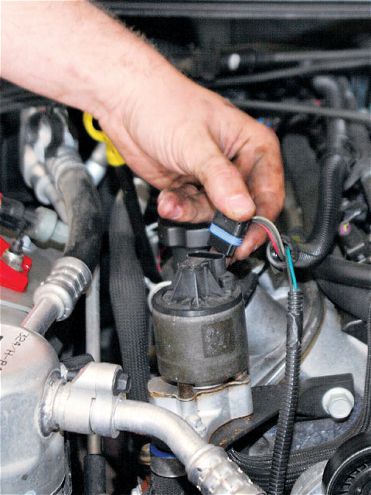 The car is then lowered, the aftermarket strut tower brace is removed, and the EGR valve's wiring harness is disconnected before the two 10mm bolts that mount the EGR valve to the cylinder head-mounted bracket are unbolted.
The car is then lowered, the aftermarket strut tower brace is removed, and the EGR valve's wiring harness is disconnected before the two 10mm bolts that mount the EGR valve to the cylinder head-mounted bracket are unbolted.
According to Brian Lohse, co-owner of RPM, "We have installed Jet-Hot headers on several F-bodies and one of our employees has them on his 10-second Trans Am. The headers fit well and the Sterling finish coating has proven to be very durable, even under race conditions. The headers, Y-pipe and intake manifold swap produced good power, but another 5-10 rwhp could have been gained with a custom tune. Since the car was scheduled for a camshaft swap the next weekend, tuning would take place then instead, as a higher duration and lift cam requires a custom tune as well. The best indicator of the power capabilities of the car will occur when the cam is installed and the engine is tuned to its potential. If, for example, we had first installed the camshaft and a custom tune before upgrading to the Jet-Hot headers and the SLP LS6 intake, the test results would likely indicate that the headers and intake yielded greater gains. Rather than focusing on trying to maximize this portion of the test, we will concentrate on the total power package and optimize the combination after the camshaft is installed."
By increasing the airflow into the motor and freeing up the exhaust system, this T/A is primed and ready to take the next leap forward in power. Stay tuned for Part II when we install a Comp cam and related valvetrain hardware to turn this car into a "cam-only" missile.
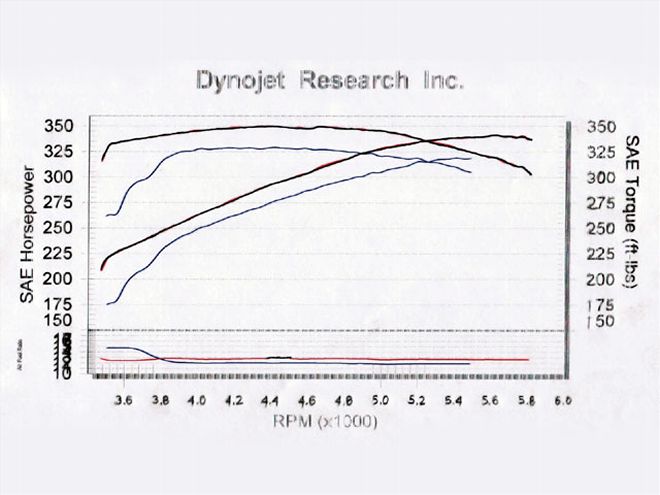
Dyno Testing & Results
Testing of the WS6 '00 Trans Am was performed at Real Performance Motorsports (RPM) in Lewisville, Texas. RPM has a Dynojet Model 248C dyno capable of measuring up to 1,200 horsepower and is optioned with the above-ground kit and the Commander wide-band 02 sensor so air/fuel ratios can be charted.
The barometric pressure, air-inlet temperature and SAE correction factors for the runs are listed below. Correction factors use a standardized SAE calculation, which include reference temperatures of 77 degrees F, and a barometric pressure of 29.23 inches of mercury.
Key engine parameters: air-inlet temperature (AIT). Maximum values are noted unless otherwise stated. Peak and average horsepower and torque are dyno pulls recorded between 3,800 and 5,800 rpm.
Dyno-PeakHPHP GainsTorqueTQ GainsBaseline319.0 329.3 Headers/LS6 Man.344.825.8350.921.6 Dyno-AvgHPHP GainsTorqueTQ GainsA/F Avg.Baseline289.5 319.0 12.4Headers/LS6 Man.308.519.0339.020.012.7Baseline Test parameters
Jet Hot Headers & SLP LS6 Intake Manifold Test parameters
Recommended Tools: